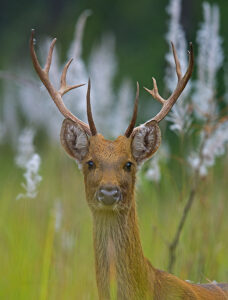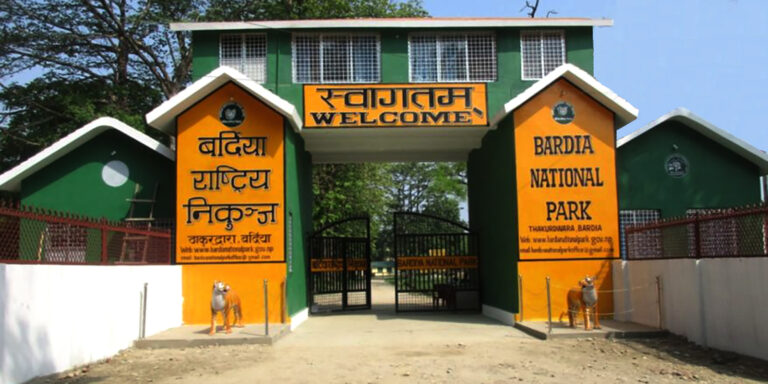Nepal is one of the leading countries in tiger conservation, with its protected areas offering thrilling opportunities to spot these magnificent big cats. Among the various national parks, Bardia National Park has become a standout destination for tiger enthusiasts. Let’s explore Nepal’s 6 five tiger habitats and understand why Bardia is the best choice for tiger spotting, even though it ranks second in tiger population

1. Bardia National Park – Nepal’s Hidden Tiger Treasure Bardia National Park, located in the far western region, is home to 125 Bengal tigers. Spread across 968 square kilometers, it offers the perfect blend of dense forests, grasslands, and riverine habitats that support the growing tiger population.
Why Bardia Is the Best for Tiger Spotting: High Tiger Density: With 125 tigers, Bardia is the second-largest tiger reserve in Nepal but offers the highest chance of sightings due to its open terrain and expert-guided safaris. Fewer Tourists, More Wilderness: Unlike Chitwan, Bardia remains less crowded, providing a serene and authentic jungle experience. Variety of Safaris: Walking safaris, jeep safaris, and even overnight camping allow visitors to explore tiger territories in unique ways.
Expert Local Guides: Many guides in Bardia have grown up around the park, ensuring you get unparalleled tracking expertise. Conservation Success: Bardia has become a global example of successful tiger conservation efforts, with numbers steadily increasing over the years. Other Wildlife: Along with tigers, you can spot elephants, one-horned rhinos, leopards, and over 500 bird species. The Karnali and babai River adds a magical touch, with opportunities to see crocodiles, otters, and Gangetic dolphins. —

2. Chitwan National Park – The Pioneer in Tiger Conservation Chitwan National Park, Nepal’s first national park and a UNESCO World Heritage Site, houses 128 tigers, the highest in the country.
Highlights: Dense Tiger Population: Despite its high numbers, tiger sightings are more challenging due to the park’s thick forests and larger tourist crowds. Diverse Wildlife: Besides tigers, Chitwan is home for rhinos they have over 600 rhino, gharials, and a variety of bird species. Accessible and Popular: Its location and reputation make it an easy choice for tourists, though this also means less exclusivity compared to Bardia. —
3. Parsa Wildlife Reserve – Emerging Tiger Territory Parsa Wildlife Reserve, which neighbors Chitwan, has a growing tiger population of 41 individuals.
Why Visit Parsa: 
Untouched Trails: Fewer visitors make Parsa a peaceful alternative for wildlife enthusiasts. Expanding Habitat: Efforts to connect Parsa with other tiger habitats like Chitwan have boosted its conservation best place to spot wild buffalo significance. 
4.shuklaphanta National Park – Vast Grasslands, Growing Tigers Located in the far-western Terai, Shuklaphanta National Park is home to 36 tigers. Its expansive grasslands and wetlands create a unique setting for wildlife. Features: Ideal for Birdwatchers: Besides tigers, it hosts an impressive variety of birds and the largest herd of swamp deer in Nepal. Remote and Peaceful: Less tourist activity means a quieter, more intimate safari experience. —
 5. Banke National Park – A Neighbor to Bardia With 25 tigers, Banke National Park is a vital part of western Nepal’s tiger conservation corridor, linking habitats with Bardia and beyond. Why Visit Banke: Pristine Landscapes: Its untouched forests make it a hidden gem for nature lovers. Combine with Bardia: Many travelers pair Banke with a visit to Bardia for an extended wildlife experience. best place to spot four horn antelope
5. Banke National Park – A Neighbor to Bardia With 25 tigers, Banke National Park is a vital part of western Nepal’s tiger conservation corridor, linking habitats with Bardia and beyond. Why Visit Banke: Pristine Landscapes: Its untouched forests make it a hidden gem for nature lovers. Combine with Bardia: Many travelers pair Banke with a visit to Bardia for an extended wildlife experience. best place to spot four horn antelope
Bardia vs. Chitwan
Why Bardia is the Best While Chitwan

has slightly more tigers (128 compared to Bardia’s 125), the experience in Bardia is far superior for several reasons: 1. Better Sightings: Bardia’s terrain and fewer crowds give visitors a higher chance of spotting tigers.
2. Authentic Wilderness: Bardia’s quieter, less commercialized environment makes it ideal for nature lovers seeking solitude.
3. Unique Activities: Walking safaris, camping, and community interactions in Bardia add depth to the experience.
4. Proven Conservation Success: Bardia tiger population has increased significantly in recent years, showing the park’s commitment to wildlife protection. Conclusion: Bardia is Nepal’s Tiger Paradise From its thriving tiger population to its immersive safari experiences, Bardia National Park stands out as the best destination for tiger spotting in Nepal. Whether you’re a wildlife photographer, conservationist, or adventure seeker, Bardia promises unforgettable encounters with the king of the jungle.






